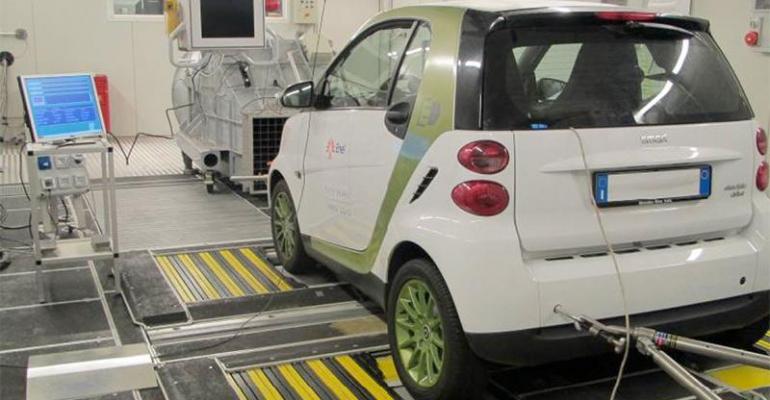ISPRA, Italy – A new laboratory will help a joint research partnership between the U.S. and the European Union aiming to harmonize technology and standards supporting electrified transport on both sides of the Atlantic by the time plug-in vehicles enter the mainstream.
Politically, the move to work together on the transatlantic interoperability of electrified vehicles and smart grids means there is a concrete interest – at least at the government level – in developing an open solution allowing for competing but compatible technologies.
The goal is to avoid creating a fragmented landscape in which each actor along the EV supply chain operates vehicles and charging platforms and smart grid systems with different and sometimes incompatible standards.
This is the premise behind the EU’s establishment of the European Interoperability Centre for Electric Vehicles and Smart Grids, a state-of-the-art laboratory located at the EU’s Joint Research Centre in Ispra, Italy.
Inaugurated Oct. 29, the EIC combines four laboratories that bring together knowledge and test facilities in the areas of EV efficiency, electric and hybrid exhaust emissions, electromagnetic compatibility, smart grids, high-powered electric chargers and battery testing. Its mandate is to work closely with a twin center in America, the U.S. Dept. of Energy’s Argonne National Laboratory in Chicago, to ensure next-generation EVs and smart grids are fully interoperable and compatible on both continents.
Under the partnership, European and American scientists will be in permanent contact to promote a common approach in the testing of relevant EV and SG equipment. Scientists will participate in each other’s inter-laboratory comparisons and together will analyze and develop harmonized standards, testing methods and technology validation.
The EIC will develop a single language that will benefit the environment as well as automakers in the U.S. and EU, Maroš Šefčovič, vice president-energy for the EU executive, the European Commission, says at the center’s inauguration.
“It will minimize trade barriers and increase the global market for innovative products and services for the EU and U.S. producers and consumers.”
Plugging In Anytime, Anywhere
What’s being done at the EIC lab in Ispra is “pre-normative testing and research that will support future EU and U.S. policy regarding EV and smart grids,” Alois Krasenbrink, head of the sustainable transport unit at the EU’s Joint Research Center, tells WardsAuto.
High-powered chargers provided by a few auto-industry suppliers already have undergone some testing, he notes.
“The idea is to facilitate universal charging that allows any EV to plug in and charge anywhere, anytime. To this end, some testing has been done to see how different models of high-powered chargers function in diverse climates and temperatures and on different terrains, to see how the components operate and if there are any problems, technical or otherwise.”
Krasenbrink says the EIC will collaborate with the Argonne National Laboratory mainly on harmonizing test procedures for vehicles, batteries and interoperability to facilitate EV compatibility with products from global suppliers. Testing also will be done to identify gaps in standards or technology and validate proposed approaches to solve those gaps.
The EIC works side-by-side with the Joint Research Center’s energy security, systems and market unit (SGILab), whose head, Marcelo Masera, says: “We are collaborating on different aspects, such as connecting models of local and regional automobile transport, including potential electric vehicles with grid models, or studying the behaviour of EV chargers in different scenarios.
“We will pursue further synergic work as need be, like for example, regarding electromagnetic interference.”
The SGILab’s mandate is to test the interoperability of existing smart-grid technologies, systems, applications and devices.
“Regarding SG, we have not tested any specific branch of automobiles. We also will rely on industry for the supply of (some of) the systems we will test.” Masera tells WardsAuto, adding the SGILab already has started linking with other JRC sites across Europe to perform real-time, high-capacity SG system and distribution simulations.
The lab also has a joint research program with the U.S. Dept. of Energy’s national renewable energy laboratory (NREL) in Golden, CO.
Masera says the work being done with its partner facility in the U.S. will range from carrying out real-time simulations of different architectures of distribution/transmission grids powering a fleet of EVs; testing the integration of power electronics from information exchange, networking and communication technologies to advanced sensing, measurement, protection and actuation devices; and analysis of different phenomena that can have negative effects on communications or power quality, such as harmonics and electromagnetic interference).
As for the benefits for automakers, Masera says the companies “can eventually benefit from the results of our tests by gaining a deeper knowledge of how grids might work in different scenarios, and the limits and conditions set by the power infrastructure. Because interoperability is really about different components, systems, appliances and devices working together.”





